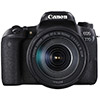
Numerically, there’s so little difference between the Canon EOS 80D and the newer EOS 77D that we expect them to offer something very similar to one another. But do they? Let's investigate. Design and ergonomics Measuring 139x105.
2x78. 5mm, the EOS 80D is a touch bigger than the EOS 77D, that camera shaving off a few mm here and here at 131. 0x99. 9x76. 2mm. With its battery and card in place it’s also heavier too, weighing around 730g next to the EOS 77D’s 540g.
Canon EOS 80D
Canon EOS 77D
As a more substantial, mid-range option, it’s no great surprise that the EOS 80D also offers weather sealing, something that’s lacking from its newer sibling.
Around the back, the only difference of any significance is that the menu pad on the EOS 77D has direct access to specific functions (White Balance, Picture Styles and so on) while also offering a quick control dial around it. The EOS 80D adheres to the template set out by previous double-digit EOS models in not having options directly marked on the menu pad.
Canon EOS 80D
Canon EOS 77D
Perhaps the most significant changes between the two are on the top plate. While both bodies have been equipped with top-plate LCDs, Canon has been able to make the EOS 80D’s noticeably larger. There’s still a good deal of information contained with the EOS 77D’s screen, although its small size means it looks a little cramped.
There are also more direct controls in this area on the EOS 80D, with AF, metering and drive mode options in addition to the AF area selector, ISO and top-plate illuminator options present on the EOS 77D.
Image quality
The EOS 77D and the EOS 80D each sport a 24. 2MP APS-C CMOS sensor, and both of these have phase-detect pixels incorporated into their design. This means that both can offer Canon’s Dual Pixel CMOS AF system for live view and video focusing, although they also share the
same 45-point AF system when using the viewfinder.
Canon EOS 80D
Canon EOS 77D
We shouldn't expect image quality to be entirely the same however, as there is a difference in processing. The EOS 80D pairs its sensor with Canon’s DIGIC 6 processor, but the newer EOS 77D employs the more up-to-date DIGIC 7 engine. Canon claims this has helped to improve noise performance at higher ISOs and also subject tracking among other things.
This combination also means that there’s a full stop difference in terms of available ISO settings. Whereas the EOS 80D spans a native range of ISO 100-12,800 and finishes this off with an expansion equivalent to ISO 25,600, the EOS 77D runs from ISO 100-25,600 as standard and offers an ISO 51,200-equivalent setting on top of this.
Special features
One area where the two split from each other by some margin is with their batteries. Whereas the EOS 80D is juiced up for around 960 shots per charge, the EOS 77D can only manage around 600.
The EOS 80D also offers a higher maximum shutter speed (1/8000sec next to the EOS 77D’s 1/4000sec) and also a higher flash-sync speed (1/250sec vs the EOS 77D’s 1/200sec).
Canon EOS 80D
Canon EOS 77D
Its 7fps burst speed is also a frame-per-second faster than the 6fps offered by the EOS 77D, although, possibly thanks to the new processor, the EOS 77D can carry on shooting JPEGs until the card is full, unlike the EOS 80D which can only last for 110 frames.
There’s far less between them when set to shoot Raw images, however, with the EOS 77D managing 27 frames at the same speed and the EOS 80D a slightly lower 25.
Other advantages of the EOS 80D include a pentaprism viewfinder with approx. 100% frame coverage and 0. 9x magnification, next to the EOS 77D’s pentamirror viewfinder with 95% coverage and 0. 82x magnification. The EOS 77D’s viewfinder also has an eye sensor, something that the EOS 80D does not offer.
Finally, the EOS 77D has built-in Bluetooth alongside standard Wi-Fi and NFC, while the older EOS 80D just makes do with the latter two.
Video quality
Both cameras are reasonably equal when it comes to their video specs, and neither offers 4K shooting, but there are differences.
Both capture Full HD video up to 60fps and work with lens-based image stabilisation systems to help keep images sharp and videos steady, but the newer EOS 77D boasts a five-axis Digital IS system too.
Canon EOS 80D
Canon EOS 77D
This helps stabilise video footage when a non-stabilised lens is used, although it can also work in conjunction with lens-based IS systems.
Canon has also furnished the EOS 80D with both headphone and microphone sockets, while the EOS 77D only has a microphone port.
Conclusion
With its stronger battery life, better viewfinder, weather-resistant design and faster burst rate, the EOS 80D is likely to appeal to those after a camera for sports and action photography, and just generally for outdoor use. Its higher maximum shutter speed also makes using the EOS 80D with wider-aperture lenses in bright sunlight easier.
While the EOS 77D is perhaps aimed at a less demanding audience, it does have a handful advantages. It’s smaller and significantly lighter, with a newer processing engine on board and a broader ISO range. As such, out of the two, it's possibly the option with wider appeal.
. digitalrev.com2017-5-8 03:00





